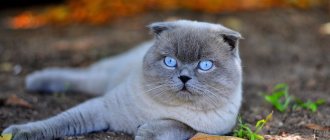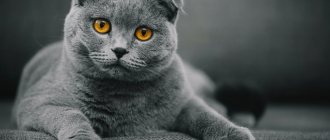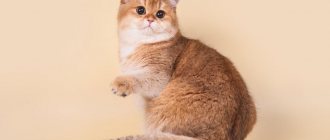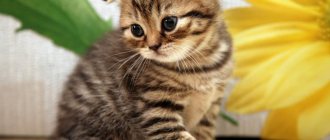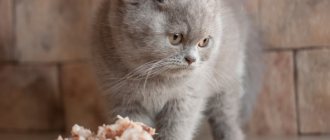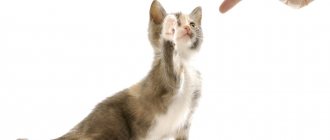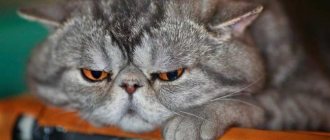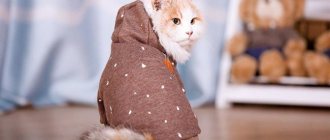Scottish cats are quite popular animals all over the world. But if you ask the average person about their color, the most common answer will be blue. These are the cats we most often see in films and commercials. But in fact, this breed has a lot of color variations. And today we will tell you about them.
Read the article about Scottish Folds on the Mister Cat portal.
Solid (solid, plain)
A solid color implies the absence of any slightest admixture of other shades. The surface of the fur is colored evenly on all parts of the body. The Scots once upon a time considered gray or blue to be the most common color. These are the favorites most often found among breeders. But today seals with other colors are also gaining more and more popularity: white, chocolate, black, brown, cream, red and fawn (which literally means the color of a young deer). Sometimes it happens that nature interferes with the uniform color of the fur and leaves a mark of a different color there. Such cats noticeably lose value because they are considered a breed defect.
Blue White Cream Black Cinnamon Chocolate Lilac Fawn Red
Breeding Scottish Fold cats
You cannot breed animals without proper education or at least experience, since breeding selection, mating, pregnancy and childbirth can be very difficult, and you must be mentally and financially prepared for this.
"Scots" reach sexual maturity by 9-10 months, but you should not breed a pet at this age - it is better to wait until 18 months. During the female's first heat (usually at one year of age), it is also better not to mate her with a male, but wait at least until the second or third heat. Early pregnancy negatively affects the health of a young mother and her babies.
The choice of the male is of great importance: after all, what the offspring will look like and what health the young animals will have depends on him.
Remember that you cannot breed a fold-eared cat with a fold-eared cat. One of the parents must be a straight-eared Scot. If both parents are lop-eared, the offspring will be unviable, with many defects.
Mating is carried out with an experienced male and on his territory. The cat is brought to the cat on the second day of estrus and left for 2-3 days. Be prepared that the female may not become pregnant right away - this is not a big deal, try again the next time she is in heat.
The pregnancy of a fold cat lasts approximately 65 days. Moreover, if labor began 1-2 days earlier, this is normal. But if it is 5 days earlier, then the babies most likely will not survive.
The mother's birth should take place in a calm and quiet environment. It is better to place the cat in a box or closet, after laying a soft bed or blanket there. It is important that the animal can calmly get out of the box without jumping high.
If the pregnancy itself is relatively easy for a fold-eared cat, then it is better to invite a specialist for childbirth. Sometimes lop ears require a caesarean section.
Point (point)
The more common name for this color is color point. It is characterized by the fact that the main color of the animal turns into a darker color at the tip of the muzzle, tail, ears and paws. This is due to the fact that in the blood of such animals there is a special gene that affects the darkening of the hair in those parts of the body where the temperature is low.
There are several variations of this color, which are shown in the table below, there may be others:
| Color name, photo | Main color | Additional color |
| Seal Point | Light beige | Brown |
| Lilac Point | White | Lilac |
| Blue Point | Pale blue | Dark blue |
| Chalklit Point | White | Brown |
| Cream-point Cream-blue-point | Pale cream | Cream |
| Red point | Pale cream | Ginger |
| Tabby (lynx) point | Any | Stripes to match the main color |
| Torty point | Tortoiseshell | Red or cream spots on the base coat color |
Torti (turtle)
It should be noted right away that you can only buy a turtle girl. In males, this color is not provided by genetics. But if you do come across a cat like this, then this is a big exception, which, however, does not increase its cost, but, on the contrary, reduces it.
Tortoiseshell color is considered to be fur on which spots of different colors (black, chocolate, blue, lilac) alternate with red or cream marks. For breeders, a particularly important indicator is the intensity of pigment expression and uniformity of location.
Blue + cream markings
Black + red markings Chocolate + red markings
Smoky (smoky, smoky)
The main condition for this color is that the hairs at the base of the body must have a silver-white tint. Those. the silvery-white hair turns into another color, such as black or blue. This phenomenon is called typing and occurs as a result of a dominant silver gene. The smoke can be different, for example, chocolate.
There are often cats with additional patterns on their fur, but according to color rules this should not be the case.
Smoky chocolate Smoky black Smoky blue
Don't confuse this color with a solid color! If you're not sure, part your cat's fur and see what color is at the base of his fur.
Distinctive features
Taking a closer look at the photo of the Scottish Fold, even an inexperienced observer will immediately notice the unusual ears. But this is far from the only feature of the breed.
- Average torso size in adulthood.
- The physique is harmonious and dense.
- Short and thick coat. It should be soft, almost plush to the touch and fit snugly to the body.
- Wide ears with the upper part tilted forward, almost completely covering the ear opening, and are very distant from each other.
- Large, wide-set eye sockets with round openings.
- Eye colors are amber, blue and emerald.
- Harmonious physique – equal width of hips and shoulders, voluminous chest.
- Short, almost invisible neck.
- Round or oval head.
- The limbs are long, rounded with strong paws.
- Proportionately long tail, medium thickness. Mobile.
Read here Laperm: description of the breed, keeping a purebred cat and features of its choice (130 photos)
Any change in these signs at the exhibition will result in points being deducted or even disqualification.
Tabby (tabby)
Such cats have stripes of an unusual shape and a different color than the main color. The most common marks are on the forehead, for example, in the shape of the letter M, light spots on the back of the ears, a necklace on the chest, rings on the paws and tail, curls on the cheeks, eyes outlined as if with shadows.
Breeders distinguish several variants of tabby. According to the type of pattern, they are marbled (shaded), tiger (mackerel) and spotted (spotted).
Brindle Spotted Marble
There is a complex classification of Scots tabby dogs based on combined colors and shades. They are presented in the table below:
| Name | Main color | Pattern color |
| Silver | Silver | Black |
| Silver blue | Light blue, white undercoat | Mantle on muzzle, tail and sides |
| Red | Light red | Bright red |
| Brown | Copper | Black |
| Blue | Cream blue | Bright blue |
| Cream | Pale cream | Beige or dark cream |
| Cameo | White | Bright red |
Chinchilla
Cats of this appearance are quite rare, which is why their prices are much higher. With the chinchilla type of color, each hair is white and only 15% of it at the end is colored either golden-blue, gold, or silver. The Blue Golden Chinchilla is the rarest of the three.
Silver
Gold
Blue golden
Ticking
Looking at these cats, it seems that their fur shimmers so much that it is difficult to determine what color it is. Such animals are quite expensive. If we look at a single hair, we will see that its coloring is far from monotonous - stripes of different colors alternate across it, and the tip is always dark.
Black silver ticked
Golden ticked
Raising a Scottish Fold cat
Despite its cute appearance, the Scottish Fold considers itself a full-fledged member of the family. Like a child, she must be raised from the first day in the house. Considering that kittens of this breed are very smart, training will not be so difficult.
The future owner must understand the habits of Scottish cats in order to properly adjust the process of accustoming them to the rules of living in a family. Thus, Scottish Folds do not tolerate loneliness quite well. You shouldn't leave them alone for a long time. As soon as the baby gets enough sleep, he will begin to look for entertainment. Therefore, scattered small objects, broken vases, and chewed wires await the owner after a long absence.
The pet will want to spend a lot of time in the arms of its beloved owner or next to him. Moreover, he sits not only on his lap, but also on the table in front of the computer or on the bed. If it seems cute to a baby, then an adult cat is already starting to irritate. Therefore, it is important to teach your cat not to climb onto objects that are not intended for this purpose.
How to act correctly in a situation when a pet is wrong depends on the owner. The main thing is not to shout, chase away or even beat the animal. You can take five to ten minutes to communicate with him, play, throw a ball. Before going to bed, dedicate 15 minutes to your cat and keep him busy playing. This will reduce the risk of being woken up at night.
The mother's upbringing of the baby is quite strict, so it is necessary to firmly stop his pranks and wean him from bad habits. However, you shouldn’t poke a fold-eared dog with your nose. Animals remember insults for a long time and will find an opportunity to take revenge.
It is the owner’s responsibility to accustom the pet to using a scratching post and litter tray. The little Scotsman is taken to these places whenever possible and praised for correct behavior.
In any case, the main thing in raising a baby is the love, patience and perseverance of the owner.
Toilet training
Scottish Folds are cats with high intelligence, but this does not mean that they do not need to be raised from childhood and not trained to use a litter tray.
Until 3 weeks of age, kittens go to the toilet with the help of their mother cat, who licks their anus and massages their tummy with her tongue. In the future, when the baby moves around the house on his own, he will see where his mother goes to the toilet and will begin to repeat after her.
But you shouldn’t place much hope on the cat: the new owner needs to make an effort to train the kitten to use the toilet, since at first it is difficult for him to endure, and he relieves himself wherever he has to.
On average, a kitten learns to use a litter box in a new home from 2 to 7 days. It’s better to immediately purchase a litter box: this way your pet will feel comfortable and safe. Take a toilet model “for growth”, as the kitten will grow up and no longer fit inside the structure, and getting used to the new potty may take a while.
Any litter will do, but Scottish owners most often buy clay litter - it reminds cats of soil where they can bury their deeds. To find out which litter is right for your animal, buy a small quantity of each type and observe the kitten’s reaction.
There is no need to scold the baby and poke his nose into a puddle if he went to the wrong place - this can provoke stress and fear of going to the toilet. It is better to remove the urine with a napkin, wipe the area with a weak bite solution or a special product that repels cats with its smell. If a four-legged dog smells its urine in a certain place, it will continue to go there.
If your baby persistently does not want to go to the litter box, he may not like the place where he is standing. Try moving the potty to where it will be more convenient for the kitten to use it.
Shedded (shaded)
With this type of color, two-thirds of the hair starting from the base is white, and the remaining part can be red, silver or gold. On the chin, belly and lower surface of the tail the color is light. The shaded color does not allow spots or stripes except those located on the forehead or paws.
Red shaded
Golden shaded
Silver shaded
Wang
Representatives of the Scottish breed with a similar color have white coat color as the main color, and the tail and muzzle are decorated with a different color or a combination of both (torti). There may also be spots on the body and paws.
Breed Features
A good advantage of the Scottish cat is its good learning ability and love of cleanliness. Most cats of other breeds love to take revenge, but the Scotsman will never do this. From childhood, they quickly understand the toilet and learn to sharpen their claws in the right place.
The pet has a quiet voice, and he makes it only when he is hungry or calls for help. The cat has powerful paws and a body, he moves gently and gracefully.
You can go on a trip with this breed, as cats can easily tolerate travel. They quickly get used to new places and often participate in exhibitions.
The Scots have a calm and balanced character. This breed feels comfortable in an apartment, as they do not like to live in the yard. A fold-eared cat does not require a lot of space and care, but you need to give the pet the necessary attention. It is best to take the animal outside for socialization purposes.
In order for cats to be friends with other pets, they need to be taught friendship from childhood. They can easily get along with any dog, as they have an easy-going character.
Scottish Fold cats are friendly and affectionate in nature. It is important that the animal is raised from the very first days in the house. Then you will be able to raise a good and cute cat. The main thing is to love and caress your pet, and then the owner will receive reciprocity.
Harlequin
This coat color is very similar to the Van. The same colored tail and muzzle, but the main difference between the harlequin is the presence of spots on the body. Outwardly, such cats really look like the hero of an Italian comedy.
The rarest colors of Scottish cats
Several years ago, the highest price was set for kittens of unusual silver and gold shades. But in the modern cat market there are more and more of them. Today, ticked Scots and golden chinchillas are considered the most expensive.
Scottish straight golden chinchilla
Interesting! The most common iris color among Scots is gold. However, there are some exceptions. Usually the eye color matches the coat. Blue or multi-colored eyes are quite rare, these animals can be white, bicolor or tortie. Orange iris is a very beautiful, but the rarest eye color in this breed.
Kinds
Interestingly, kittens are born with straight ears, and up to 3 months they can droop on their heads. Depending on whether the ears are flattened or not, Scottish Folds are divided into 4 types:
- Scottish Straight - short hair and straight ears;
- Scottish Fold - short coat and drooping ears;
- Highland Straight - long hair and straight ears;
- Highland Fold - long coat and drooping ears;
Genetics of Scottish cat colors
In cats of this breed, 2 genes predominate, which are responsible for the red and black color. One of them acts as dominant, and the other as recessive (i.e., the one that is suppressed). There is also a 3 diluent gene, which is responsible for the saturation of the pigment. These genes are combined and as a result we get a variety of colors: from the well-known blue to the cheerful-looking harlequin.
By the way, while the kitten is still small (several weeks), it is impossible to say exactly what its color will be. The final coloring is formed when, after a child's molt, the coat is replaced by an adult coat. Usually the color is ready by six months, although it may change slightly for another 1.5 years.
Care
Scottish Folds are not picky and do not require any maintenance skills.
Eyes
Month-old kittens are prone to eye infections. First of all, you need to show them to the doctor. Standard treatment is to periodically wipe with a cotton swab soaked in chamomile infusion or medicine.
Ears
The weak point of all such cats. Cleaning is carried out at least once a week. It is better to replace cotton swabs with tampons with a special liquid. It is important to be careful so that your little pet gets used to the procedure and does not experience fear.
A typical disease - ear mites - manifests itself in the appearance of a brown crust in the ear. At the first symptoms, you need to see a veterinarian as soon as possible.
Wool
The fur does not require special care. During shedding, it is enough to brush no more than once a week. Increased attention is paid to a pet that walks along the street in the spring-autumn period - there is a high probability of acquiring a company of ticks.
Water treatments
Professional breeders offer the following method of accustoming to water: at first you need to wrap the baby in a wet towel, then reward him with a treat. Thus, he will understand that water is not scary.
Before bathing in the bath, you need to protect your ears from moisture getting into them by plugging them with cotton pads. The water temperature should be warm and as comfortable as possible for the pet. To do this, measure the water with your elbow. Human shampoo will cause skin problems.
It is necessary to use special tools designed taking into account her needs.
Claws
It is recommended to purchase specialized nippers: they do not separate the claw, but immediately cut off the excess. It is extremely important not to touch the vessels inside, as this is painful for the pet.
Health and vaccination
Peculiarities of breeding have caused the appearance of several hereditary diseases:
- Glaucoma, cataract, entropion. Also read the article about eye diseases in cats.
- Demodicosis, eczema, allergies.
- Congenital deafness, tendency to otitis media.
Even if the owner does not plan to let the pet out of the apartment, vaccination is mandatory, since infections can be brought into the house on shoes or clothes. The first vaccination is given at the age of three months; you can learn about further procedures from your veterinarian.
Scottish cat color charts
When purchasing a Scottish kitten with a passport from a breeder, most likely you will see markings of numbers and letters there. This is an international code used in the classification accepted among breeders. The Scottish breed includes four cats: fold-eared (Scottish Fold), straight-eared (Scottish Straight), long-haired fold-eared (Highland Fold), straight-eared long-haired (Highland Straight).
This is what the color code looks like: XXX.xx.NN.NN.NN.(NN) , where:
XXX . Abbreviated name of the breed in three capital letters: SFS - Scottish Fold, SFS 71* - Scottish Straight, SFL - Highland Fold, SFL 71* - Highland Straight.
xx . Lowercase letters indicating the main coat color (up to two):
| Letter (designation) | English name | Russian name |
| a | blue | blue |
| b | chocolate, brown, chestnut | chocolate, brown, Havana, champagne |
| c | lilac, lavender | lilac, lavender, platinum |
| d | red, flame | red |
| e | cream | cream |
| f | tortoiseshell, patch | tortoiseshell |
| g | blue-cream, blue-tortie | blue cream, blue tortoiseshell |
| h | chocolate-tortie | chocolate tortoiseshell |
| j | lilac-tortie | lilac tortoiseshell |
| n | black, ebony, seal, sable, ruddy | black, ebony, seal, sable, wild |
| o | sorrel, cinnamon, honey | sorrel, cinnamon, honey |
| p | beige fawn | yellow-brown, beige |
| q | sorrel tortie | red-brown tortoiseshell |
| r | beige fawn cake | beige tortoiseshell |
| s | silver, smoke | silver, smoky |
| w | white | white |
| y | golden | golden |
| z | unregistered | unregistered |
NN.NN.NN.(NN) - values of pairs of digits (up to 3 main and 1 auxiliary):
- Numbers from 1 to 35, which decipher the color features (harlequin, van, smoke, etc.):
| Letter (designation) | English name | Russian name |
| 01 | van | van |
| 02 | harlequin | harlequin |
| 03 | bicolour | two-color, bicolor |
| 04 | mitted/white point | with white markings (for color points) |
| 09 | little white spots | white spotting (1-2 cm) |
| 11 | shaded | shaded (1/4 of the top part of the hair is darkened) |
| 12 | tipped, shell | veiled (1/8 of the top part of the hair is darkened) |
| 21 | tabby, agouti | striping, agouti factor |
| 22 | blotched, marble | marble |
| 23 | mackerel, tiger | mackerel, tiger |
| 24 | spotted | spotted |
| 25 | ticked | ticked or Abyssinian |
| 31 | burmese | Burmese |
| 32 | tonkinese | Tonkinese |
| 33 | himalayan or siam | Himalayan, Siamese, point |
| 34 | Singapore | Singaporean |
| 35 | abyssinian | Abyssinian |
- A pair of numbers from 51 to 54 indicating the length of the tail:
| Letter (designation) | English name | Russian name |
| 51 | rumpy | taillessness |
| 52 | rumpy riser | remainder of the tail – 1-2 vertebrae |
| 53 | stumpy | bob – 7-13 cm. curled tail |
| 54 | longy | long/normal tail |
- A pair of numbers from 61 to 67 indicating eye color:
| Letter (designation) | English name | Russian name |
| 61 | blue | blue |
| 62 | yellow, golden | yellow, orange, golden |
| 63 | oddeyed | disagreement |
| 64 | green | green |
| 65 | burmese | Burmese cat eye color |
| 66 | onkinese | Tonkinese cat eye color |
| 67 | himalayan or siam | eye color of Himalayan and Siamese cats |
- A pair of numbers 71 (straight) or 73 (dropping), indicating the shape of the ears.
History of the Scottish Straight cat breed
Scottish Straight cat
Scottish Straight are the same Scottish folds, but with a modified position of the ear. Straight ears do not have a characteristic crease and are set straight, and this, in fact, is the only external sign that distinguishes them from their fold-eared counterparts. Scottish cats are considered one of the youngest cat breeds. The first cat with an unusual, flattened ear shape appeared on a Scottish farm in the early 60s. Surprisingly, the ancestor of modern folds and straights had no pedigree and simply chased mice through the barns of local peasants.
The first official Scottish breeder was an ordinary villager, William Ross, who adopted a kitten from the aforementioned Fold. A few years later, professional breeders also joined the process. At the same time, experts witnessed an interesting phenomenon: in the litters brought by even the most purebred Scottish dogs, babies with erect ears appeared. Of course, no one intended to separate such individuals into a separate breed. And kilometer-long queues did not line up for straight-eared kittens, because against the backdrop of touching folds, they were outright losing. But here nature itself intervened.
Very soon, Scottish breeders noticed that attempts to strengthen and strengthen the lop ears of animals had a negative impact on their health. The mutated gene responsible for the flatness of the ear folds began to inhibit the function of the skeletal apparatus of cats. As a result, the Scots began to suffer from thickening of the bones and osteochondrodysplasia. To keep the breed afloat, breeders rushed to look for “new blood” that would help the Scottish survive and reduce the number of their genetic defects. Through trial, error and outcrossing, it was discovered that the healthiest and most beautiful offspring can be obtained from crossing a Fold cat and a straight-eared male of the same breed. It was thanks to this discovery that breeders and felinological associations finally turned their attention to straight-eared Scots. Well, in 2004, the Scottish Straight subspecies received official recognition from the World Cat Federation and the status of an independent breed, which sharply increased the attractiveness of straight-eared cats in the eyes of potential buyers.
How coat color affects the character of a Scotsman
When purchasing a pet, you should not chase fashion; it is better to trust your preferences and tastes. The main thing is that the cat turns out to be “yours” in temperament and character. By the way, some cat owners are sure that the color of the fur affects the behavior of the animal and leaves an imprint on its character.
White and light colored
You want to cuddle these babies endlessly. But they, as a rule, do not like increased attention to themselves. Although they are very loyal to the owner, they are extremely wary and wary of other people. Among some peoples there is a belief that a white cat brings good luck. Whether this is true or not is not known for certain. But the white color can cause a lot of problems for the cats themselves, since 5% of all snow-white cats are born completely deaf. Previously, it was believed that deafness was the fate of absolutely all white-furred tails, but later scientists proved that this is not so. But when buying such a kitten, you should still be more careful.
Black
Despite all the existing prejudices and myths regarding black cats, in practice they are one of the friendliest towards people. They like to stay close to their owner all their free time and always keep him in sight. Charcoal cats are wise, quick-witted, and keenly aware of a person’s mood.
Redheads
Such animals are a ray of sunshine in your home. It is believed that a ginger cat in the home is the key to an indispensable increase in well-being. Those with fiery fur are very playful, willful, cheerful and curious creatures. The golden shades of fur that are fashionable today are characteristic of more formidable animals, whose disposition can hardly be called friendly. And golden Siamese cats are generally considered the worst tailed cats.
Blue and silver
Silver and blue fluffies are real aristocrats. Calm, balanced, noble. They love their owner devotedly, although they are not always ready to demonstrate this publicly. It is believed that these four-legged pets are able to calm and relieve stress in humans. In addition, cats of this color are absolutely not vindictive.
Two-color
Such cats are most in demand among buyers. In addition to their interesting color, they have an easy-going disposition, are friendly, and kind even towards children. Bicolor cats love their owners very much and get along well with other pets.
Tortoiseshells
We are talking specifically about cats, since among cats this color is not a sign of the breed, but, on the contrary, its defect. Pussy turtles are extremely friendly, intelligent, and even slightly flirtatious. They enjoy communicating with new people and love their owner. In some countries, having such a cat at home is a symbol of wealth and prosperity.
Nutrition, dietary features
The diet of Scottish Fold kittens should be approached thoroughly. Don't worry if your Scottish Fold kitten has a poor appetite at first. This most likely happened because he was not yet used to the new place. Food cannot be given directly from the refrigerator; it must be at room temperature. At the age of 2-4 months, babies are fed often - 5 times a day. When the kitten reaches 4-8 months, they feed it 3 times a day.
After 8 months, you need to feed it 2 times a day, like an adult cat . The set of products for kittens must necessarily include meat (beef), poultry (turkey, chicken); game can only be given in boiled form. You can give eggs, but only boiled and only the yolk. For vegetables, you can give cabbage and grated carrots. For full development, Scottish Fold kittens should be given fermented milk products.
You can also feed lop-eared kittens with premium and super premium food. They contain the vitamins and minerals your pet needs in a balanced form. It is strictly forbidden to give smoked, fried and salted foods, as well as sausages and any human food. This will undermine the health of the developing organism of the Scottish Fold kitten.
Return to content
